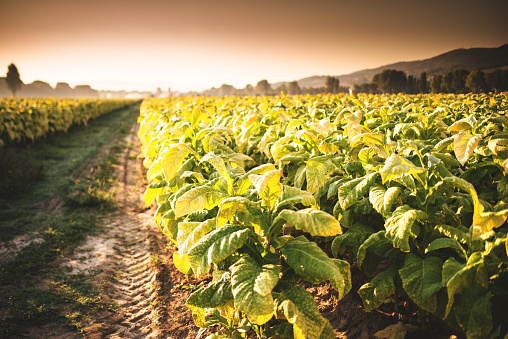Are you curious about the different flavors that cigars offer? Do you want to know how to identify the subtle notes of a cigar?
If so, this blog post is for you! We’ll explore the different taste notes associated with cigars, from earthy and woody notes to spicy and sweet ones. Learn how to distinguish each flavor for a more enjoyable smoking experience.
Table Of Contents
−- Cigar Tasting Basics
- Flavors to Look For
- The Impact of Wrapper Types
- Strength and Body
- The Influence of Aging on Taste
- Pairing Cigars with Beverages
- Identifying Tastes in a Cigar Blend
- Cigar Tasting Notes by Region
- Detecting Flavors from the Smoke
- Creating a Cigar Tasting Journal
- Aroma and Aftertaste Evaluation

Cigar Tasting Basics
Cigar tasting is a unique and enjoyable experience. Knowing the basics and recognizing the different notes and flavors can help you appreciate the nuances of your favorite cigars.
To understand the different flavor notes of a cigar, it’s important to understand the tobacco-growing regions, wrapper types, aging and blending processes, and the impact of beverage pairings. By understanding these elements, you can identify different flavor profiles in cigars from different regions and subtleties in the same cigar blend.
Additionally, you can learn how to detect flavors from the smoke itself and create your cigar-tasting journal, to track the flavors of your favorite cigars over time.
Flavors to Look For
Cigars can have many flavors, from sweet to spicy, nutty to earthy, and even floral. Sweet notes are often associated with cocoa, dark chocolate, maple, caramel, molasses, marzipan, honey, nougat, rum, and chocolate.
Fruity profiles often include citrus flavors such as orange, lemon, and lime. Leather is another popular flavor profile. And for those who don’t know the scent of wet leather, spicy notes can be detected in cigars.
Regardless of your flavor profile, it’s important to remember that cigar tasting is all about personal preference. Before you start tasting cigars, it’s helpful to familiarize yourself with the basics of cigar tasting so that you can accurately identify the flavors you experience in each cigar.
Cigar aficionados know that each cigar has its unique flavor. But for those of us who are new to the world of cigars, it can be hard to identify and distinguish between different taste notes.

Earthy Notes
Earthy sensations from a cigar differ from tasting notes such as chocolate, cream, and pepper. The earthy qualities of cigars can be recognized by those who are used to them and experienced with cigar smoking.
Examples of earthy notes are shavings, cedar, cut grass, and dirt. One of the main factors that play a role in a cigar’s flavor is the soil in which the tobacco plant has been grown.
Nutty Notes
Nutty tasting notes are typically more common in mild to medium-bodied cigars, adding a creamy and rich texture to the smoking experience. Depending on the type of cigar, you may detect flavors like walnut, peanut, hazelnut, chestnut, cashew, and almonds.
The nuttiness is a huge component of tobacco flavor profiles, providing a buttery element that ties together the other flavors. Cigars with nutty notes tend to be lighter in texture, resulting in a delectably creamy smoke.
Coffee Notes
Coffee notes, in particular, provide a unique and complex flavor profile to cigars, making them an attractive option for many cigar enthusiasts. These notes tend to be more on the darker side of the flavor spectrum, with aromas and flavors of espresso, mocha, and dark chocolate being some of the most common.
Other coffee-like notes include kopi, orange blossom, and dark cherries. When looking for a cigar with coffee notes, it is important to consider the other flavors that may be present, such as bitterness and earthiness. Ultimately, cigars with coffee notes can provide an enjoyable experience for cigar lovers looking for something unique.
Cedar Notes
Cedar is just one of many kinds of wood commonly tasted in cigars, with oak and the occasional hickory flavors following suit. One easy way to identify the cedar notes in a cigar is to smell the wrapper or cut the cap without lighting it.
The aroma of the cigar, out of the box, is one of the cedar notes. The wrapper, likewise, tastes of cedar and musky wood. This can often impact the cedar-lined humidor in which the cigar has been stored. Spanish cedar is also used in the manufacturing process of cigars, which can contribute to a distinct flavor. Cedar tastes are often more prominent in mild to medium cigars than in full-bodied cigars.
Spicy Notes
Regarding spicy notes, black pepper, red pepper, and cayenne are the most common descriptors. But that’s not all there is to the spicy flavor profile. You can also find herbal and spicy flavors such as nutmeg, cardamom, tea, black or red pepper, clove, and many more nuances that can be found in different cigars.
Chocolate Notes
When it comes to chocolate notes, the Maduro wrapper leaf is one of the most common reasons for those sweet notes. It rounds off most blends perfectly and adds a depth of richness to the smoke. Many cigars hint at cocoa, dark chocolate, or even molasses.
Honey Notes
Honey notes may be the perfect choice for those who desire a sweeter flavor profile. Honey notes are a delightful addition to the cigar-smoking experience, providing a subtle yet delightful sweetness that helps balance out the other flavors in the smoke. The sweetness of honey is often balanced by earthy and leathery tones, which add an extra dimension of complexity to the overall smoke.
Citrus Notes
Citrus notes are a great way to add a bit of zing to a cigar. This is usually attributed to improper fermentation or some of the tobacco used in the cigar. The most common citrus notes in cigars are orange, lemon, and lime. These notes can range from subtle to bold, depending on the blend of tobaccos used. Citrus notes are most commonly found in cigars from Honduras, which tend to produce dark tobacco with exotic, earthy, and spicy notes.
Leathery Notes
Leathery notes are a unique flavor in cigars and can be quite complex. While they may be associated with tannins, there is much more to the profile. Earthy notes are commonly found in medium to full-bodied cigars, and they often add a lot of depth and complexity to the overall taste. When smoking a cigar, you may experience sweet and savory flavors that come and go as you puff.

The Impact of Wrapper Types
The wrapper of a cigar is the outermost layer and plays an important role in determining the overall flavor. Different types of wrappers, such as Connecticut, Corojo, Habano, and Maduro, carry distinct characteristics that impact the taste.
For instance, Cameroon wrappers are among the sweetest tasting cigars, while Habano wrappers produce a stronger aroma and intense flavor with a profile of earthy spices. Moreover, how much a wrapper influences flavor depends upon the type, seed origin, and how it’s used. A cigar maker, when blending, must be mindful of all these elements to create a unique flavor profile.
Strength and Body
When it comes to the strength and body of a cigar, there is a spectrum between light and full. Medium-strength cigars can still be full in flavor and body, with pepper, tannins, and an overall deep flavor.
Strength is classified as mild, medium, or bold, while body pertains to flavor’s depth (or fullness). It’s important to note that the strength of a cigar does not have anything to do with its taste or flavor; rather, it’s determined by how much nicotine is present in the cigar.
Knowing the difference between strength and body can help determine the best cigar for your palate.
The Influence of Aging on Taste
Aging has a considerable effect on the taste of cigars. Aficionados debate whether aging a cigar improves flavor, but many agree that it tends to mellow and round out the flavor profile. Aging can also add complexity to a cigar, as the various tobaccos in the blend marry together over time.
Generally, flavors become smoother, less sharp, and even sweeter with age. However, smoking your cigars right away is probably your best bet if you prefer sharper flavors.
Pairing Cigars with Beverages
One of the best ways to enhance the flavor of a cigar is to pair it with the right beverage. With a wide range of options, from beer to whiskey, you can create a unique taste experience. As a general rule, it’s important to match the intensity and flavor profiles of the cigar and drink.
For example, tannins in young red wines can make a cigar taste harsh, while sweeter cigars pair well with more bitter drinks. Whiskey, cognac, and rum are traditional partners for cigars, but you can also explore more adventurous options like craft IPAs with their citrusy notes. Experimenting with different pairings can be a great way to discover new flavors and create an unforgettable experience.
Identifying Tastes in a Cigar Blend
There are many factors to consider when it comes to identifying tastes in a cigar blend. For example, the wrapper type and the aging process can influence the flavor profile. But, the key to truly understanding a cigar’s flavor is to experience different cigars and try to extract the best flavors from them.
The best process for reviewing cigars is to use all five senses: sight, touch, smell, taste, and hearing.
Sight involves looking at the color of the wrapper and inspecting the overall construction. Touching the cigar will help you assess its weight and texture. The aroma should be noted as this can provide clues about the flavors that may be present.
Finally, take a pull on your cigar and listen for any subtle sounds that may be present. This will help you detect nuances in flavors and any construction inconsistencies. By using all five senses, you can develop an appreciation for cigars and find your favorite flavor profiles.
Cigar Tasting Notes by Region
Cigar tasting notes vary depending on the region in which the tobacco is grown. Cuban cigars, for example, are known for their earthy flavor profile due to the unique composition of the soil.
Meanwhile, Nicaraguan cigars tend to have a more robust and spicy taste. Other regions, such as Mexico and Honduras, may offer cedar, coffee, and cocoa notes. The Dominican Republic-grown cigars are known for their smoothness and subtle sweetness.
It is important to note that even within regions, tastes can vary due to climate, soil type, and other factors. Exploration is key to understanding and appreciating the vast array of cigar flavors available today.
Detecting Flavors from the Smoke
Smoke is a great way to detect flavors in cigars. It carries the aromas and tastes of a cigar and can be a great way to experience the nuances of the cigar. When you smoke a cigar, you can detect four basic flavors—sweet, salty, acid, and bitter—through your mouth.
Additionally, you can pick up more subtle notes, such as floral or woody aromas, when retro-hale. Fruity or sweet flavors can also be detected in some cigars due to the different wrapper types. The strength and body of a cigar can also influence the tasting notes, and cigars with more tasting notes are often considered more complex.
As the cigar burns, these notes often transition from beginning to end. Cigar lovers can learn to appreciate and identify these flavor nuances through practice and experience and even create tasting journals to keep track of their observations.
Creating a Cigar Tasting Journal
Creating a cigar-tasting journal is important to becoming a more informed cigar smoker. Each time you try a new cigar, take the time to jot down your impressions in your journal. Include things like the cigar’s name, wrapper type, flavors you detected, and overall experience with the cigar.
This will help you to remember how you felt about it and to compare it to other cigars you try in the future. Keeping a cigar-tasting journal is also a great way to track your notes on cigars and refer back to them in the future.
Aroma and Aftertaste Evaluation
Aroma and aftertaste evaluation is another important step in the cigar-tasting experience. The aroma of a cigar is often more closely associated with memory than taste, as we recall our favorite meals (and cigars) by the way they smell.
Cigar aroma can reveal a great deal about the flavors and strength of the blend. To properly evaluate a cigar’s aroma, you’ll need to train your nose to recognize scents like wood, earth, leather, pepper, citrus, and spice.
Additionally, you can detect subtle notes like coffee and dark chocolate in the aftertaste. Once you’ve become proficient in recognizing aromas, you can begin to hone in on identifying flavor notes in the cigar blend.

jay
Self proclaimed cigar expert. I've been smoking since 2010. I've practically lived at a cigar lounge from 10am to 10pm and trying every new cigar that came out for years.

